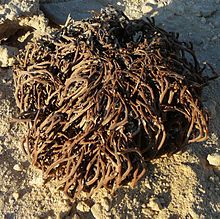Anastatica
| Anastatica | |
|---|---|

| |
| Anastatica hierochuntica | |
| Scientific classification | |
| Kingdom: | Plantae |
| Clade: | Tracheophytes |
| Clade: | Angiosperms |
| Clade: | Eudicots |
| Clade: | Rosids |
| Order: | Brassicales |
| Family: | Brassicaceae |
| Genus: | Anastatica L. |
| Species: | A. hierochuntica
|
| Binomial name | |
| Anastatica hierochuntica | |
Anastatica is a monotypic genus of plants in the family Brassicaceae containing the single species Anastatica hierochuntica. The plant is a small gray annual herb that rarely grows above 15 centimetres (6 in) high, and bears minute white flowers. It is a tumbleweed[1][2][3] capable of hygroscopic[citation needed] expansion and retraction. However, it is not a true resurrection plant,[2] because the plant's dead tissues do not revive and turn green.
This species is not to be confused with Selaginella lepidophylla, also sometimes referred to as "rose of Jericho",[4] or "false rose of Jericho", which is a true resurrection plant that can revive from a dried state and regain the processes of respiration and photosynthesis.
Names[edit]
Common names include Maryam's flower, flower of St Mary, St. Mary's flower, Mary's flower, white mustard flower and rose of Jericho.[2]
Range[edit]
Anastatica is found in arid areas in the Middle East and the Sahara Desert, including parts of North Africa and regions of Iran, Egypt, Lebanon, Israel, Syria, Iraq, Jordan, Pakistan and India.[5][6]
Description[edit]
A plant with great resistance to desiccation, its branches have the property of contracting with dryness, remaining closed and dry for many years, reopening with moisture or contact with water, regaining all its freshness and beauty. After the rainy season, the plant dries up, dropping leaves and curling branches into a tight ball, and aestivates. Within the ball, the fruits remain attached and closed, protecting the seeds and preventing them from being dispersed prematurely. The seeds are very hardy and can remain dormant for years. Moistened again in a later rainy season, the ball uncurls and the plant wakes up from its dormant state, which causes the capsular fruits to open to disperse the seeds. If water is sufficient, the dispersed seeds germinate within hours. After it curls, it is easy for the wind itself to lift and drag it large distances, making them obligatory travellers through steppes and deserts crossing the borders of various countries in Asia and disseminating their seeds for all of them.
A fraction of the seeds are dispersed in the vicinity of the parent plant by raindrops hitting a spoon-like appendix on the seeds. The seeds have a sticky coat that helps them adhere to the soil,[3] but they also may be carried downstream by surface wash.[3][5] However, seeds swept downstream do not survive.[5]
The process of curling and uncurling is completely reversible and can be repeated many times. The ability of the plant to do this is attributed to the presence of trehalose,[7] a disaccharide sugar involved in several mechanisms of cryptobiosis. Although the rehydrated plant sometimes is described as putting out new leaves, flowers, and fruits,[8] this is disputed; instead, the seeds may sometimes germinate and sprout new plants while still seated in the fruit on the dead parent plant.
Anastatica has been described as the most famous tumbleweed.[9] Once dry, the ball is said to become detached and is dispersed by wind. This tumbleweed habit has been interpreted as a mechanism of avoiding burial in dunes.[10] However, Anastatica may possess this habit only in the literature,[9] or tumble only rarely, if uprooted by accident.[11]
Culture[edit]
Since ancient times it was used as an element to guess the climate, since being a vegetable hygrometer, the wise man or shaman, predicted it with success. In dry weather the plant remains completely closed; in wet weather, it opens slowly; if it threatens rain, it opens in a very showy way and with more or less speed according to the proximity of discharge of the clouds.
Gallery[edit]
-
Flowers
-
Dried up
-
In water
See also[edit]
References[edit]
- ^ William Francis Ganong (1921). A Textbook of botany for colleges. MacMillan Co. p. 604. page 359
- ^ a b c James A. Duke; Peggy-Ann K. Duke; Judith L. duCellie (2007). Duke's Handbook of Medicinal Plants of the Bible. CRC Press. p. 552. ISBN 978-0-8493-8202-4. pages 36-37
- ^ a b c G. E. Wickens (1998). Ecophysiology of Economic Plants in Arid and Semi-arid Lands. Springer. p. 343. ISBN 3-540-52171-2. pages 204-205
- ^ Quisquis (1886). "Tumble-weeds". Botanical Gazette. 11 (3): 68. doi:10.1086/325923. S2CID 224838371.
- ^ a b c Anastatica hierochuntica in Flora of Pakistan @ efloras.org
- ^ Friedman, Jacob; Zipporah Stein (March 1980). "The Influence of Seed-Dispersal Mechanisms on the Dispersion of Anastatica Hierochuntica (Cruciferae) in the Negev Desert, Israel". The Journal of Ecology. 68 (1): 43–50. doi:10.2307/2259242. JSTOR 2259242.
- ^ G. E. Wickens (1998). Ecophysiology of Economic Plants in Arid and Semi-arid Lands. Springer. p. 343. ISBN 3-540-52171-2. pages 121-122
- ^ Baynes, Thomas Spencer; Kellogg, Day Otis; Smith, William Robertson (1897). The Encyclopædia Britannica. Werner Company. pp. 175–176. pages 175-176 Please note that [Anastatica] is not listed as an article in [EB9] or [EB1911] so no wikilink is available
- ^ a b O. Appel; I. A. Al-Shehbaz (2003). "Cruciferae". In K. Kubitzki; C. Bayer (eds.). The families and genera of vascular plants. Vol. 5: Flowering Plants: Dicotyledons: Malvales, Capparales and Non-betalain Caryophyllales. Springer. pp. 75–174. ISBN 3-540-42873-9. page 83
- ^ L. J. Templin (1890). "Distribution of plants". The Kansas City Review of Science and Industry. 3: 612–614.
- ^ W. F. Ganong (1896). "An outline of phytobiology". Bulletin of the Natural History Society of New Brunswick. 13: 3–26, page 1 errata. page 16



